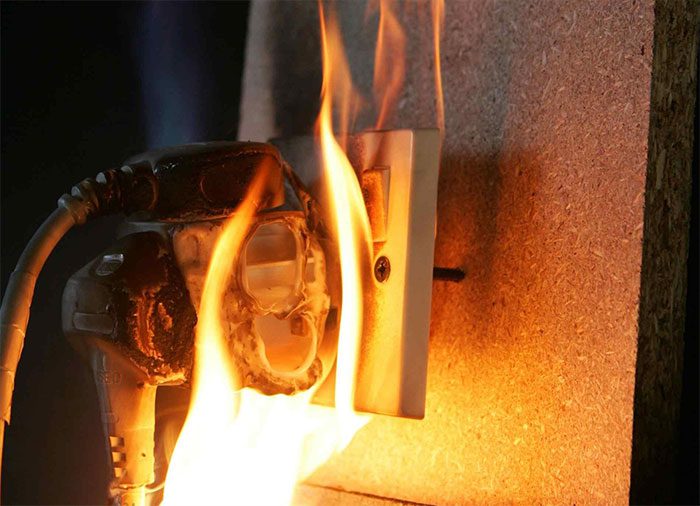Recently, there have been numerous house, factory, and warehouse fires causing significant damage to both life and property. The majority of these fire incidents are related to electrical systems and equipment.
In this article, the author focuses on the causes of fires due to overload or electrical short circuits.
Currently, in every household and workshop, after the electricity meter, all power companies are equipped with a suitable protective switch. This protective switch is commonly referred to as a circuit breaker (CB). In some places, it is also called automatic switch or automatic fuse.

Unsafe electrical outlets can also lead to fires and explosions.
The automatic fuse is responsible for isolating electrical devices such as lights, fans, electric stoves, kettles, and motors… or a part of the electrical system from the power grid in cases of overload, short circuit, or electrical leakage. Here, we focus on two cases that can cause fire: overload and short circuit. A modern protective switch has the function of protecting against overload and short circuit for electrical circuits and devices.
Overload: The protective switch is equipped with a thermal cut-off mechanism, which consists of a bimetallic strip with two metal plates that have different thermal expansion coefficients. The current from the electrical devices (electric stoves, air conditioners…) passes through a heating coil that heats the bimetallic strip, causing it to bend due to heat. When the bend exceeds a certain threshold (for a predetermined current intensity, e.g., 16A), the bimetallic strip activates the cut-off mechanism.
The thermal cut-off mechanism has a delay. The bimetallic strip only activates the cut-off mechanism when the current through the load exceeds 3 to 5 times the rated current of the type B automatic fuse. Type C or D automatic fuses may require a current 5-10 times or even 10-20 times higher than the rated current.
Thermal cut-off fuses only protect devices against overload, not against short circuits.
For example, an electric stove connected to a power source by a double wire. The current not only heats the stove but also the electrical wire. Because users may not pay attention to the type of electrical wire, its cross-section, and resistance…
A significant current used to heat the stove warms the wire, causing the insulating plastic layer to gradually melt and deteriorate. Eventually, due to damage to the insulating layer, a short circuit could occur between the two conductors. In this case, if the user relies on a CB (protective switch) that only protects against overload, the CB may not cut off the electricity in time, and the entire electrical wire could melt due to the short circuit, leading to a fire.
A similar situation may occur if the homeowner uses an old fuse or even replaces a blown fuse with a piece of “super durable” wire!
Short Circuit: In addition to the thermal cut-off mechanism with bimetals, a modern CB or automatic fuse also has an electromagnetic cut-off mechanism.
When a short circuit or electrical contact occurs between two electrical wires, a significant current flows through a coil, creating a magnetic field strong enough to pull an iron core within the coil, activating the cut-off mechanism. This process occurs very quickly, almost instantly (approximately 0.01 seconds).

Electromagnetic cut-off mechanism.
Thanks to this rapid cut-off process, electrical wires and devices are not damaged, preventing fires. An automatic fuse (CB) with an electromagnetic cut-off mechanism can only be reactivated after the cause of the short circuit or electrical contact has been resolved.
A modern automatic fuse used in households includes both thermal cut-off (bimetal) and electromagnetic cut-off mechanisms. These two mechanisms are connected in series, so if either one is activated, the electrical device is immediately isolated from the power grid.
Therefore, to prevent fires caused by short circuits, we should purchase and use modern CBs and automatic fuses with electromagnetic cut-off functionality. Although they may be more expensive than fuses that only have thermal cut-off, they provide safety in the event of a short circuit or electrical contact.

Automatic fuse (CB) with electromagnetic cut-off mechanism.
In addition, to minimize fires caused by short circuits in homes, enterprises, and power companies, authorities responsible for fire prevention and fighting need to regulate and inspect automatic fuses with electromagnetic cut-off mechanisms to ensure safety even in the event of a short circuit. There should be a gradual phase-out or prohibition of unsafe fuses that only protect against overload and lack a rapid electromagnetic cut-off component when a short circuit occurs.
How to Respond When an Electrical Short Circuit Causes a House Fire
An electrical short circuit leading to a house fire is something no one wishes for. However, to mitigate risks, every family should equip themselves with knowledge on the safe use of electrical devices to minimize potential damage.
- In the event of an electrical short circuit causing a fire, immediately turn off the power switch and alert everyone to evacuate the house. Only use a fire extinguisher to put out the flames once you are sure no one is trapped inside. Also, pre-save the emergency number 114 on your phone for contacting the fire department if needed.
- Install smoke alarms in multiple locations in your home so that when an incident occurs, you can completely eliminate the risk of dying in a fire. Regularly check the smoke alarm batteries to ensure they are functioning properly. You should replace the batteries every six months.
- Never use water to extinguish electrical fires. While waiting for firefighters to arrive, stay low to avoid inhaling smoke. If clothing catches fire, roll on the ground to extinguish the flames.
- You and your family members should discuss an escape plan that includes how to exit the house and a designated meeting place.
If someone in the house suffers an electrical burn, immerse the burn in cold water and then cover it with a clean, dry cloth. If the burn is large, use a dry sterile cloth to cover the burn and seek emergency medical assistance immediately! Electrical burns can cause damage to the victim’s skin, muscles, and bones. To prevent the victim from going into shock due to the electrical burn, lay them flat on the ground with their legs elevated. Never attempt to remove burning clothing from the victim’s skin.




















































